Star Wars Outlaws review – stripped-back Ubisoft formula is admirable yet doomed

If nothing else, I’ve had a wonderful time playing Sabacc. The new variant, Kessel Sabacc, invented for Star Wars Outlaws is infinitely moreish, a simple card game that takes elements of Blackjack and Poker and a few others, and blends them into an eminently snackable bit of video game gambling. In the simplest terms, four players are each dealt a hand of two cards and take turns, through three rounds, to attempt to make a pair of the two lowest numbers possible. Drawing a new card costs a token, as does coming anywhere but first at the end of each set of rounds. When you’re out of tokens you’re out of the game; last player standing wins. I could play it all day.
In some sense this is open world Ubisoft at its best: a bit of colour off to the side, extraneous to the main story, and yet still woven into the world through unlockable cheats and sidequests and bonuses you can acquire and deploy. It’s a byproduct of the kind of development the developer-publisher has come to be synonymous with, albeit usually in derogatory terms. This is Ubisoft ‘formula’ stuff, but it’s also a reminder that the formula is often driven by generosity as much as anything. Development-as-gift-giving: have another system; chuck another mechanic on the pile; here’s one more neat little thing to do.
The problem with Star Wars Outlaws, however, isn’t that it adheres too closely to a development approach akin to hoarding, but that it does the opposite, stripping away years of accumulated video game clutter. Admirably Outlaws does this quite aggressively – Kessel Sabacc aside – but in doing so it reveals an integral issue: Ubisoft open worlds are not only fun because of their formula; they are their formula. To strip it away isn’t like peeling off some old wallpaper to reveal the original brickwork. It’s lifting up the carpet to find a whacking great hole in the ground.
It’s a great shame, because there are some nice ideas here. Star Wars Outlaws is effectively a kind of gateway open world game, pitched more broadly at the young adult crowd, a stepping stone from, say, TT Games’ Lego Star Wars to Respawn’s Jedi series. This is good – Star Wars is a family franchise! We don’t need everything to be extra mature – and it leads to a kind of breeziness and levity, but also a more manageable and, in theory, focused take on open world structure that is at first quite welcome.
After bursting free of the usual Ubisoft pre-credits funnel you’re given one of four miniature open worlds to explore in Toshara, a savannah-like moon with one main settlement, the city of Mirogana. Really, ‘city’ is a stretch – Mirogana isn’t particularly big, nor particularly dense – but it’s a serviceable first hub area, with all the necessary vendors and contract-givers and a couple of nice touches in seedy, hard-to-reach back rooms for more sweet Sabacc (though how everyone else manages to get into these rooms behind perma-locked doors, which often require a bit of grapple-hooking and remote vent-opening for you to reach, is a mystery – one of many, many cases in Outlaws where it’s best not to think too hard about it.)
Beyond the city is Toshara’s large-ish, predominantly empty open world. A bit more main questing and you’ll find space flight available to you, which in turn opens up three more planets – frosty outpost Kijimi, steamy jungle Akiva, and of course the obligatory Tatooine – as well as a bit of space itself, in each planet’s orbit. You may be delighted to hear there are no towers to scale to push back Outlaws’ fog of war here: these open world areas – really a collection of entirely distinct biomes, separated by hyper space or fast travel – reveal themselves fully on arrival.
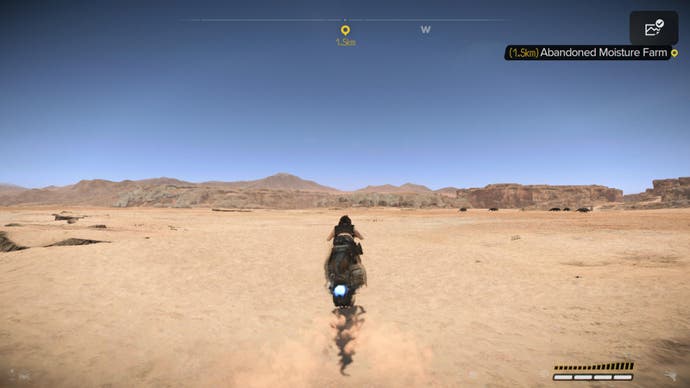
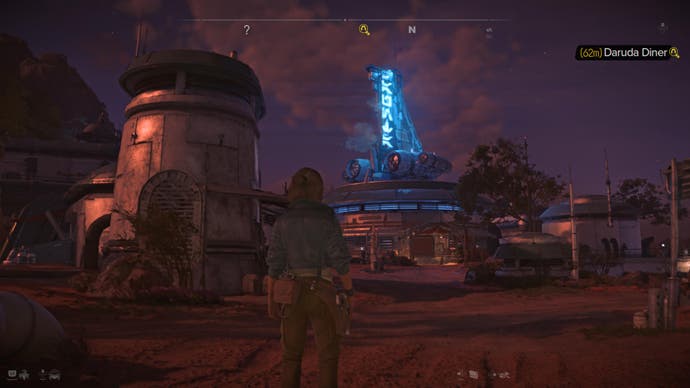
Except they also don’t. Major sections are hidden and locked off until you need to visit them as part of the main story, at which point suddenly a locked door will unlock, or a ‘speeder-restricted area’ will un-speeder-restrict itself. Suddenly you’re off on a brand new path to the great, creaking ruins of a crashed star cruiser, say, or a vast underground facility. But like much of Star Wars Outlaws, these are places which look fantastic as static images or preview beats that seem to promise vast areas of opportunity, but can fall painfully flat in practice. It means Outlaws’ most interesting spaces are always fenced away behind one-off missions featuring entirely linear, on-rails exploration and platforming sequences – the most exploration or player choice you’ll encounter is an option to sneak to the left of a large cluster of guards, waist-high crates and explosive barrels, or perhaps instead to the right.
Exploration and choice are two integral pillars of the Star Wars Outlaws pitch, and unfortunately also two of its biggest failures. Let’s stick to exploration first: platforming in Star Wars Outlaws is everywhere, and it’s dire. Not satisfied with some of the most egregious yellow paint in a modern video game, Outlaws couples this with yellow tubes on the floor that lead you to your next location, yellow arrows painted on white placards, often pointing towards large bits of yellow paint, and overt, continuous button prompts assigned to every ledge, grapple point and handlebar. The result is something several leaps beyond the faintly patronising but at least understandable yellow ledges that spark debate, to something utterly, inexcusably infantilising, regardless of the audience Ubisoft Massive is shooting for here.
All that said, there is an option to turn this off, which I discovered late into the game. But platforming is let down again beyond that with a more basic issue, in the clumsiness of Outlaws’ physics Kay’s controls – frequently I’ll find myself below a climbable ledge hammering X while waiting to be in just the right spot for the icon to appear and the action trigger. It also sparks the old problem of Outlaws then not being innately readable enough to work without such overt prompts – many unscalable ledges are half the height of ones I’ll be leaping up to in platforming sections, for instance.
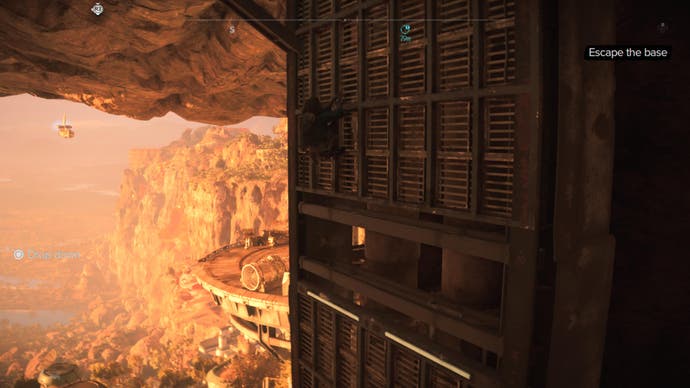

Platforming suffers, as well, from the sheer repetitiveness of the obstacles you’ll face – it’s incredible how many giant, rhythmically activating wall fans there happen to be around here – and couples unfavourably with more repetition elsewhere. There are just two puzzle types in Outlaws, for instance: a rhythm-based lockpicking one, where you need to time right-trigger pulls to a series of two or three musical bleeps; and a game of Star Wars Wordle, which starts off as a slightly bland game of logical elimination, since there’s no hard five-guess limit here, and ends as an easier and therefore even blander game of elimination when you gain access to an upgraded slicing kit that rules out most of the options for you. These are both neat at first – the Wordle clone has some lovely retro-future visual touches and audio cues, and the rhythm lockpicking is at least somewhat novel – but by the 50th, or the 100th time you’ve gone through these, mashing in symbol combinations and tapping away to the same tune again, that novelty is a very distant memory.
The same goes for Outlaws’ environmental puzzle solving, which involves Kay’s animal companion Nix, here playing a kind of BD-1 and Atreus hybrid role as both egregiously cute shoulder mascot and solve-everything remote assistant. As you navigate the world you’ll find various obstacles with conveniently Nix-sized gaps in them, where you can send him off to go hold a shutter open for you to shoot at a big power nodule, say, or push a button to open a door from the other side. Again, there are just a couple of these, and again, they tire quickly.
Worst of a bad bunch, on the exploration front, is Star Wars Outlaws’ horrible, wicked, downright cursed speeder. Star Wars games have always had trouble with speeders – a function of their original design itself really, as flimsy, overtly crashable and ludicrously fast – but this thing is something else. Not only is it a nightmare to drive, revealing the blunt edges of Outlaws’ very limited physics by slamming into near-invisible bumps and micro-ledges and coming to comically blunt, immediate standstills, it also has the unfortunate effect of emptying out the landscape.
By implementing something so fast, Massive – a maker of open world games in The Division but, crucially, open worlds based entirely in a single city – has been forced to spread its open areas as thinly as possible, meaning they’re both entirely impractical to ever navigate on foot and entirely unenjoyable to drive around on your bike. There’s a smattering of rote open world activities here – some civilians are being attacked by some syndicate or another; Nix smells a pair of special leggings buried beyond this rudimentary platforming section; there’s a guy with a gun.


But as undeniably moreish as Outlaws’ Bethesda-style trick of leaving question marks just off the main path will always be, the traversal is far too painful, and the payoff – in gameplay or narrative or otherwise – far too limited for me to ever want to go looking for them. Too often I found myself thinking of Dragon’s Dogma 2 director Hideaki Itsuno’s witheringly appropriate comments earlier this year about fast travel – ubiquitous in Outlaws – and what it says about travel itself in your game. “Travel is boring? That’s not true. It’s only an issue because your game is boring. All you have to do is make travel fun.” This is easier said than done of course, and I have sympathy for Massive in having to transition to wide open worlds from more concentrated ones, but it hasn’t worked here.
Back to player choice, and unfortunately it’s more limited here than you might expect. A key place where this manifests is Outlaws’ approach to stealth and combat, which has again been stripped back to the simplest possible implementation and, again, suffers for it. Stealth is a surprisingly major part of Outlaws. That’s understandable – this is a ‘scoundrel’ game, after all, where Kay is intentionally a regular human scraping by with underdog, and often underhand tactics. The issue is stealth is painfully basic and somehow at once both far too easy, but also far too easy to fail at the hands of some awkward systems and controls.
Often you’ll be tasked with infiltrating an enemy base – always belonging to either one of the games’ four crime syndicates or the Empire – but with your kit so limited compared to other stealth games, these can become a lengthy slog. Nix, again, is the star, capable of turning off or booby trapping enemy alarms, distracting enemies, or rushing them and jumping on their head while you leg it up for a quick punch. Much has been made of Kay’s ability to punch out helmet-wearing Stormtroopers with a single biff, which frankly is a bit of a non-issue. Far more interesting to me is the fact that, as indicated by several guard barks on discovering the crumpled bodies of their peers, Kay is in fact killing these people.
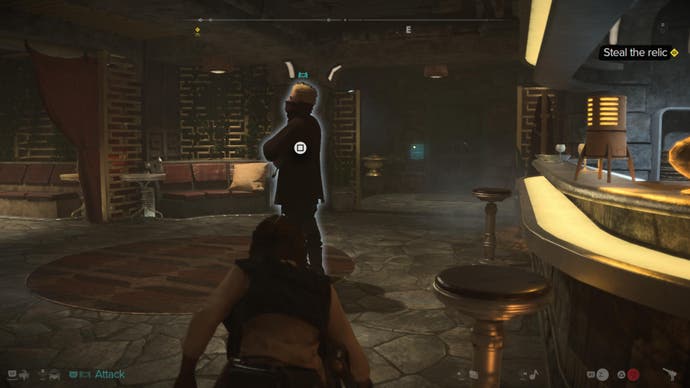
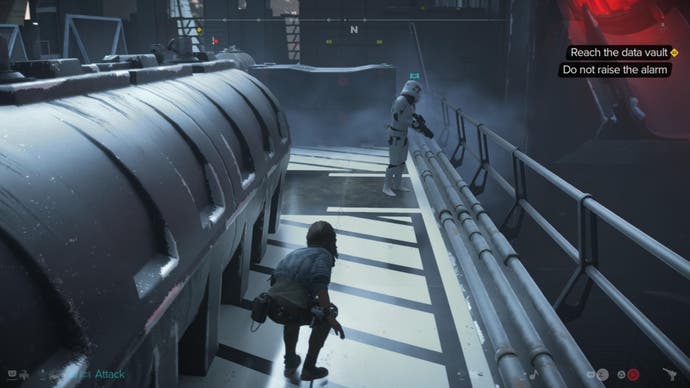
Casual unarmed brutality aside, there are more pressing issues. Enemy AI is by all modern standards quite awful, searching secret, high-security bases for all of 10 seconds after finding one of those battered bodies before resetting – this happens often, because you can’t move the bodies to hide them, and most enemies are located somewhere fairly open on their wall-staring duty. Their line of sight is comically narrow, and their hearing equally limited, as I discovered by regularly punching the life out of enemies yards away from each other, running up to them diagonally, or even triggering lengthy, red-barrel-exploding gunfights barely a dozen metres away from other parts of a base that totally ignored it.
Your own systems are equally limited, with most of the game involving sending Nix to a spot behind a trooper to dance in front of them, walking up to press Square for a (lethal) K.O., and repeating ad nauseam for about half an hour. There are also many air vents – many, many air vents – for you to squat in. Though rather than presenting as one of many sprawling, branching opportunities to navigate an outpost like in say Batman Arkham, these often function as the single linear way to get past an obstacle or through to another section. With stealth often combining platforming, puzzle-solving and stealth attacks all at once, there are moments when Outlaws genuinely feels like one, long quick-time event, as you flow from one explicit button prompt to the next.
When the alarm does go off, or you just get bored, it’s gunfight time. AI is again largely terrible here, with enemies often running around in seemingly random directions. There’s no locking to cover, so you’ll often find yourself getting clipped on the shoulder when it really feels like you should be safely in cover. Shooting itself can, at times, be good fun however. It’s a classic third-person pop-up gallery for the most part, but some enemies are a bit tougher, requiring a nice rotation between stun mode and regular mode of your blaster, with a heavier, pseudo-grenade launcher upgrade available as you progress. It’s eminently casual, which is fitting for the Han Solo template of Kay Vess and in turn makes it enjoyable enough in short bursts, though without his swagger this can end up leaning more towards a kind of wafty chaos than any kind of intentional design around style. And intentional or not, that pervading sense of imprecision grows tiresome when dealing with tougher enemies towards the end.
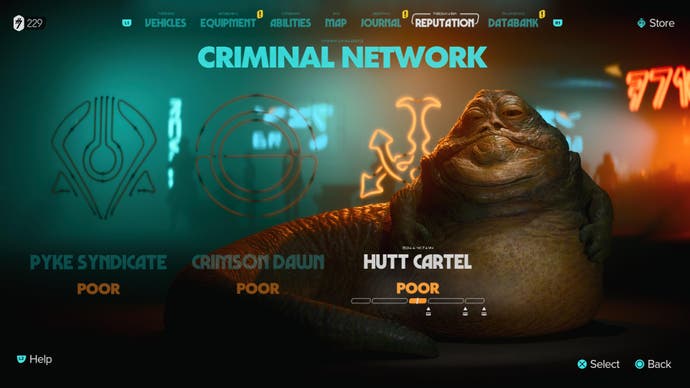
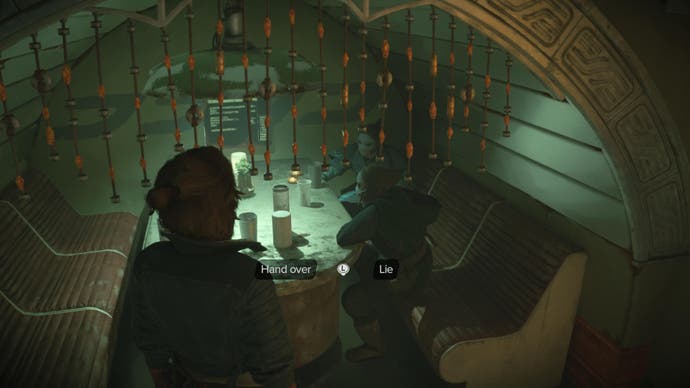
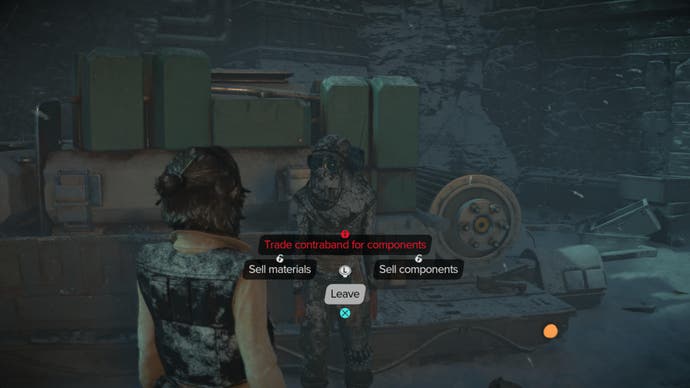
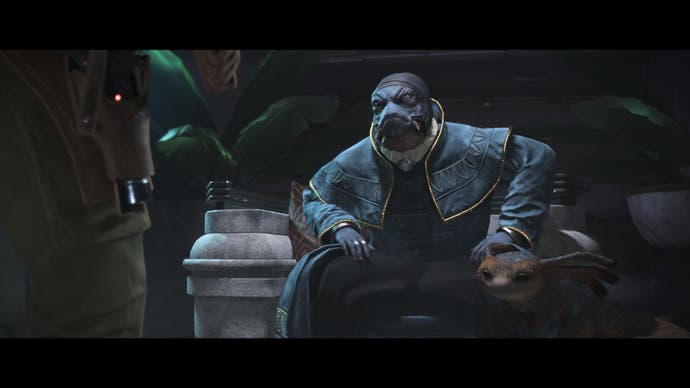
Lastly, still loosely under the topic of choice, comes Outlaws’ system of crime syndicates, and their role in Kay Vess’ story. They are loosely under the topic of choice because unfortunately, again, much has been made of a system that is ultimately very limited. The four crime gangs – Pykes, Hutts, Crimson Dawn, and Ashiga Clan – each have a very simple ‘how much do we like you’ bar. Do quests for them and the bar goes up. Backstab them, trespass in their forbidden areas, ruthlessly mow down hundreds of their grunts etc., and the bar goes down. At key moments of missions, usually right at the end, you’ll also get binary dialogue choices when presented with a last-minute chance at stabbing one in the back for another, almost always with the same dated, cop-out moral equivocation where neither side’s really in the right and you never have to feel particularly good or bad about anything.
Aside from the bluntness of the system, the consequences in general range from mild to non-existent. There’s no true bearing on the story from what I can tell. Instead, the bar nudging up or down simply results in better or worse deals at traders, some contracts temporarily opening or closing off, and the odd area toggling into or out of being restricted, until you get back in the good books. Crucially, and perhaps fatally for Star Wars Outlaws, there’s also no effect on Kay herself at all.
Kay Vess is as unchanging a character as I can remember. Played gamely by Humberly Gonzalez, Kay begins as a scrappy underdog who projects cockiness and continues at that exact level throughout, unimpacted by the people she meets, the events of the story, or anything else. Her desires are unclear to the point of parody – and almost plot point, right towards the very end – with her entire motivation being to get rid of the death mark put on her by a brush with a crime lord at the beginning, and maybe to bag a big score.
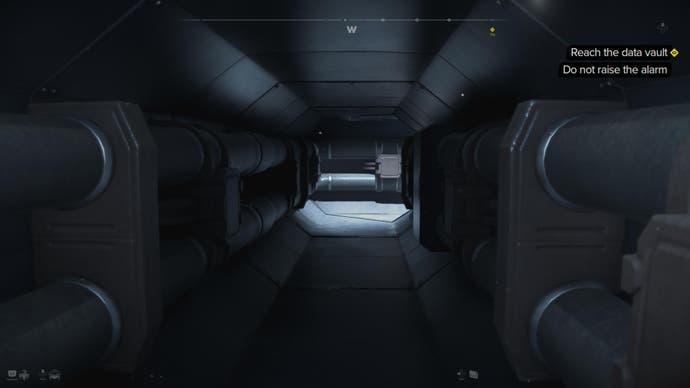
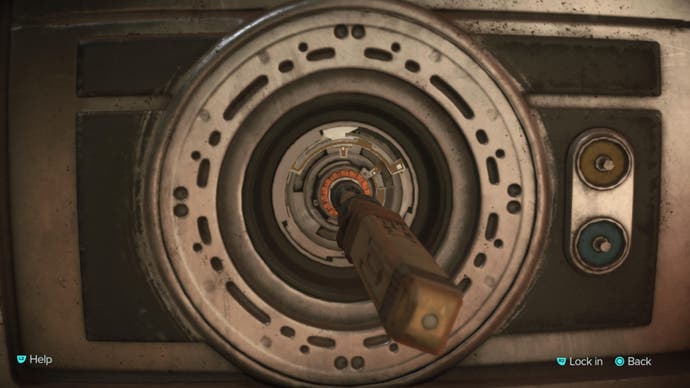
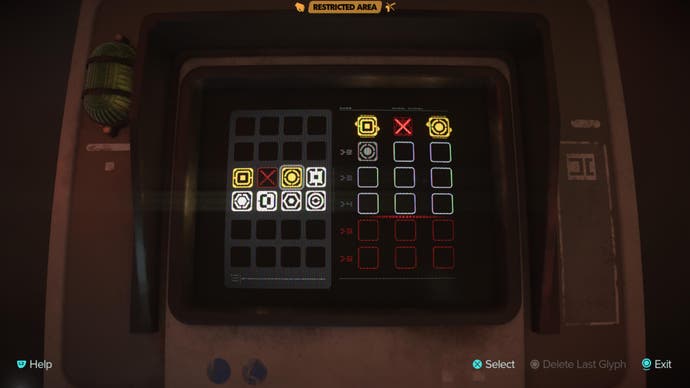
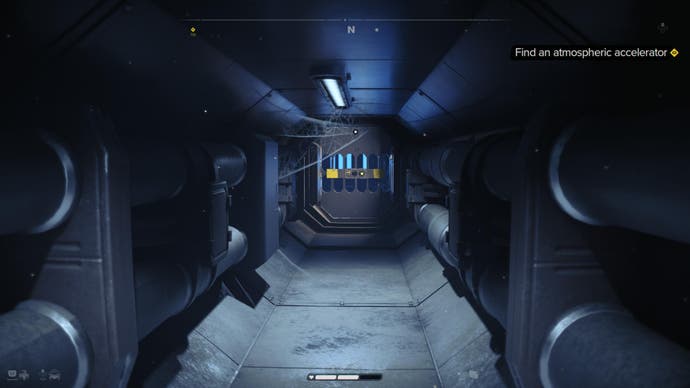
Why does Kay want to land this score so badly? What does she value or care about – or, as it seems to be nothing, why is she this much of a cynic? Far too much Disney-era Star Wars finds itself equivocating between the Rebels and the Empire, in search of complexity and grey areas in the era of antiheroes and prestige TV and no doubt because, in relentlessly expanding as a universe, there’s only so much you can get out of a simple good-versus-evil tale. Kay feels like the personification of the issue, her blankly disinterested nihilism feeling like a function of her as a simplified ‘rogue’ character spec sheet. The mistake Massive has made here is conflating a character archetype – scoundrel – with actual character.
The same struggles continue into the storytelling as a whole. This is a heist story set amongst the seedy underworld of the galaxy. Cue all of the surface-level vibes of a heist story but none of the detail or intentionality that makes them what they are. There’s rip-rollocking music and neon lights and cocky shrugs, but when a duplicitous contact is first met – a chance for noiry, pulpy heist flicks to fully lean into their atmosphere – it’s a plain over-the-shoulder chat in the flat lighting of a corridor. There are no slatted blinds here, no figures cast half in shadow, no tests of boundaries or questions of integrity. Aesthetic choices like these, basic development of characters or examination of their intentions and desires, are treated like unnecessary afterthoughts. But the reality is that these aren’t bits of set decoration that you can pick or choose between when you’re assembling your genre flick, but actually are the genre itself.
It speaks back to Outlaws’ issues with stripping away the bulk of the Ubisoft formula and finding so little underneath – or more broadly, a general misunderstanding of what you ought to be stripping away here and why. The Ubisoft open world functions so well because of how this clutter weaves itself together so intoxicatingly that you can’t help but flow from one to the next, from looting to crafting to combat to gear to unlocking another area of the world and more. The heist flick works because of its characters – their complexity, obsession or greed – as much as it does the sheer fun of actually doing a heist.
Star Wars Outlaws, by comparison, feels like it’s blagging it – much as Kay can, when regularly caught out by some far more worldly syndicate boss. The result is a series of quite painful comparisons: it lacks the branching, open stealth of an Arkham game, the systemic options of a Dishonored or the incisive, relentlessly satisfying speed of picking enemies off in Assassin’s Creed. It lacks the linear polish and charisma of Uncharted. Lacks the animation flow to its yellow-ledge platforming next to a Horizon, or the sheer joy of taking platforming and making it into an actual game in itself, as in Star Wars Jedi. And, somewhat nightmarishly for Ubisoft Massive, which couldn’t have known about this when committing to it at the time, Outlaws opts to tell a Star Wars heist story in a world after Andor, which has already done so with such sensitivity, humanity and precision that Kay and co’s cameo-ridden non-event is unfortunately left feeling lightyears behind.
A copy of Star Wars Outlaws was provided for review by Ubisoft.




